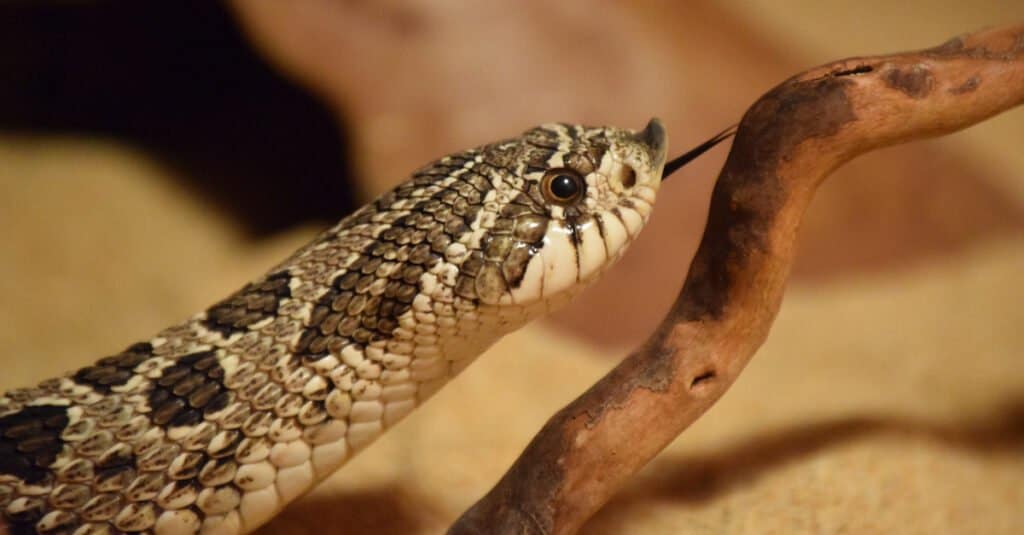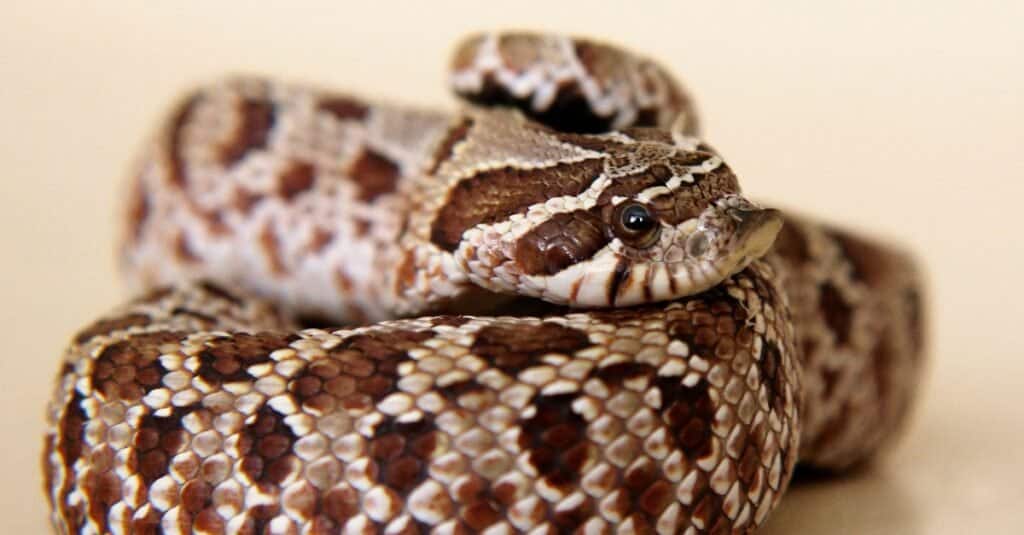Western Hognose Snake
Heteredon nasicus
Primarily solitary, these snakes only communicate with one another during breeding season.
Advertisement
Western Hognose Snake Scientific Classification
- Kingdom
- Animalia
- Phylum
- Chordata
- Class
- Reptilia
- Order
- Squamata
- Family
- Colubridae
- Genus
- Heteredon
- Scientific Name
- Heteredon nasicus
Read our Complete Guide to Classification of Animals.
Western Hognose Snake Conservation Status
Western Hognose Snake Facts
- Prey
- Rodents, lizards, eggs, amphibians
- Fun Fact
- Primarily solitary, these snakes only communicate with one another during breeding season.
- Litter Size
- 12-15
View all of the Western Hognose Snake images!
The western hognose snake is a capable actor that will transition from puffing up like a cobra to dramatically playing dead in the face of predators, but they’re actually loath to bite.
That’s an obvious advantage when looking for a pet snake — but reptile enthusiasts are also drawn to the array of colors to choose from, this snake’s mild personality, and their adorably upturned noses (hognose snake, right?). In the wild, the western hognose snake covers a prodigious range of habitats covering much of North America — and they serve a critical role in controlling local amphibian populations. They’re the perfect example of how snakes can positively impact both their ecosystem and human interests. Let’s find out more about the western hognose snake!
Western Hognose Snake Amazing facts
- Though they may look a lot like their counterpart on the other side of the United States, the lifespan of a western hognose snake is significantly longer than that of an eastern hognose snake.
- The snout of the hognose is actually a distinct scale, and these snakes use it to forage and dig through sand, foliage, and dirt.
- There are roughly 60 western hognose morphs of varying rareness. Dramatic and unusual morphs like the super arctic or the coral can come with price tags in the thousands of dollars.
- Primarily solitary, these snakes only communicate with one another during breeding season. Females lure males to their location during breeding season by putting out chemical hormones.
Where To Find Western Hognose Snake
Though their name would suggest they occupy the American coast, the range of western hognose snake habitats actually cuts directly through the middle of the continent. States with a notable western hognose population include South Dakota, Nebraska, Kansas, Oklahoma, Texas, New Mexico, Colorado, and West Virginia. To the north, western hognose populations continue into the Canadian provinces of Saskatchewan, Alberta, and Manitoba — but population levels are vulnerable in all three provinces. This is also the point where frigid weather becomes unmanageable for these cold-blooded reptiles. The southernmost location western hognose habitats extend to is northern central Mexico.
The western hognose snakes are pretty adaptable to different habitats — but whether they’re occupying a floodplain, the outskirts of a desert, an open prairie, or human farmlands, the biggest demand for the species is loose soil. The snubbed nose of this snake is a valuable asset for foraging for food, and it can also help them dig burrows for nesting, hiding, and sleeping. No matter what location they inhabit within the species’ larger range, their seasonal habits are largely dictated by the ambient temperature. Many in the northern reaches will brumate without a meal for three or four months at a time to survive the harsh winters. The dictates of the breeding season are similarly influenced by climate and weather conditions.
Western Hognose Snake Scientific name
The etymology behind an animal’s scientific name can often tell a convoluted story of historically changing naming conventions and academic politics, but the scientific name for the western hognose is actually quite straightforward. This snake bears the name Heteredon nasicus. Heteredon is a reference to the genus that encompasses the different species of North American hognose. It translates literally into English as “different tooth” — a reference to the strange positioning of these snakes’ fangs at the rear of their mouths. Nasicus is derived from the Latin word for large nose, referring to both the size and the unusual shape of this snake’s snout.
Western Hognose Snake Population & Conservation Status
The western hognose is still prolifically spread throughout much of North America, but populations in some states are feeling the impact of human intervention and climate change. Population levels are deemed as critically imperiled in Iowa, and they’re impaired in Illinois and Montana as well as the Canadian provinces of Manitoba and Alberta.
How To Identify Western Hognose Snake: Appearance and Description
The western hognose’s most distinctive point of identification is right there in the name. All hognose species have an upturned scale at the tip of their nose that helps them dig through sand and loose soil. But if you’re looking for identification between a western hognose and another hognose species, the size of western hognose snakes is slightly smaller than those of the eastern species. The western hognose’s size is bolstered by its thick body, and it’s most commonly gray or tan with roughly three dozen darker splotches scattered over its back. The belly of a western hognose is primarily black. While the coloration of western hognoses in the wild is suited to the plains and valleys they typically occupy, the dozens of morphs available extend into a huge variety of bright colors impractical for camouflage anywhere.
- An upturned scale at the tip of the nose that makes their snout look snubbed
- Roughly three feet in length with males being slightly smaller than females
- Brown or tan body with 35 to 40 darker splotches as camouflage. Coloration can vary depending on the morph
- Stomach is almost entirely black
Western Hognose Snake Pictures

©Bryn Thomas/Shutterstock.com

C
loseup of a western hognose snake, Heteroden nasicus, on old wood of a tree. The snake has a brown or tan body with 35 to 40 darker splotches as camouflage.©iStock.com/chas53

©iStock.com/Iuliia Morozova
Western Hognose Snake Venom: How Dangerous Are They?
This snake possesses a mild venom, but humans aren’t in any danger from it. Instead, this venom is used to incapacitate the favored prey of the western hognose: poison toads. In many instances, these will constitute the bulk of a hognose snake’s diet. Not only is the snake’s venom particularly effective on the amphibians they prey on, but the snake is also one of a few predators immune to the toxin that these amphibians produce. Even if they were capable of poisoning humans, bites would be rare. Though they aren’t always friendly, the facts demonstrate one of these snakes is far more likely to posture, flee, or play dead than to bite.
Western Hognose Snake Behavior and Humans
Proper identification of western hognose snakes is important because they have an important role to play in many human-adjacent ecosystems. By feasting on reptile eggs, birds, and especially toads and frogs, they keep population levels in check. As pets, hognose snakes are docile reptiles that are unlikely to lash out at humans and require little in the way of serious care once they’re given a proper home.
As is always the case with pet snakes, tank size is important. 18″ x 18″ x 24″ should be enough for a western hognose snake, though you’ll want to adjust for a bigger tank size if you’re taking care of more than one. Western hognoses can live together, but it’s recommended that you feed them separately to avoid territorial behavior.
View all 108 animals that start with WWestern Hognose Snake FAQs (Frequently Asked Questions)
Are Western hognose snakes venomous?
While these snakes have a mild venom that helps them disable their favored amphibian prey, it causes mild discomfort in humans at worst. And since they don’t normally bite humans, the issue is largely moot.
How do Western hognose snakes hunt?
They use their snout-like nose to dig through soil or sand in search of prey — usually frogs and toads — and then use their mild toxin to incapacitate and swallow their victims whole. They’re crepuscular and split their hunting activities between the early hours of the morning and the late hours of the evening.
Are Western hognose snakes aggressive?
Western hognoses rarely bite but are known to hiss and puff up as a way of chasing off threats. They’re more likely to play dead than to bite you.
Where do Western hognose snakes live?
Western hognose states cut through the middle of North America and have habitats extending from northern Mexico through the southern row of Canadian territories.
What do Western hognose snakes eat?
While they’ll sometimes eat rodents and eggs, up to 80% of a western hognose’s diet consists of toads and frogs. In many instances, they’re one of the few predators immune to the toxins indigenous amphibians produce.
Are Western hognose snakes friendly?
Western hognoses generally have a reputation for being timid, but they’re one of the better choices of pets. As long as you take care to get the right tank size and properly equip it, they can have a peaceful and happy lifespan as a pet.
How big does a western hognose snake get?
Females are bigger than males and can grow to lengths of three feet. Despite that, the facts show most only weigh half a pound or slightly more.
How much does a Western hognose snake cost?
A normal western hognose adult will cost around $200 if using a legitimate private breeder. But with dozens of morphs to choose from, these prices can quickly skyrocket. The beautiful colors of the lavender hognose can cost you well over a thousand dollars.
Are hognose snakes sometimes called zombie snakes?
Yes, the state of North Carolina issued a warning about ‘zombie snakes‘ in 2019 thanks to the habit of eastern hognose snakes playing dead and then quickly ‘rising from the dead’ once threats facing them had left the area.
What are the differences between hognose snakes and coachwhip snakes?
The main differences between hognose snakes and coachwhip snakes are length, speed, appearance, and adaptation as pets.
Thank you for reading! Have some feedback for us? Contact the AZ Animals editorial team.
Sources
- Everything Reptiles / Accessed February 11, 2022
- Plains Hognose Snake / Accessed February 11, 2022
- Arizona-Sonora Desert Museum / Accessed February 11, 2022
- Florida Museum / Accessed February 11, 2022
- ITIS / Accessed February 11, 2022
- Happy Serpent / Accessed February 11, 2022
- Illinois Natural History Survey / Accessed February 11, 2022


















